4.3 External
Flash
While most camera accessories may
be considered mere conveniences, there’s one that I consider absolutely
essential for truly serious bird photography, and that’s the external flash unit. There
are three separate reasons
for this, and it’s worth enumerating them right at the outset.
The first (and most obvious) is that birds are very often found in
shady environments (such as within a forest), where there may be
insufficient ambient light to obtain an image that is sharp, bright,
and not overly noisy. When shooting in dim environments (or on
very overcast days), you’ll often find that in order to obtain a
reasonable exposure, you need to either use a very low shutter speed
(which can lead to blurry images if the bird is moving) or use a very
high ISO setting (which can lead to large amounts of pixel
noise). Properly applied flash can, very often, substantially
mitigate these problems.
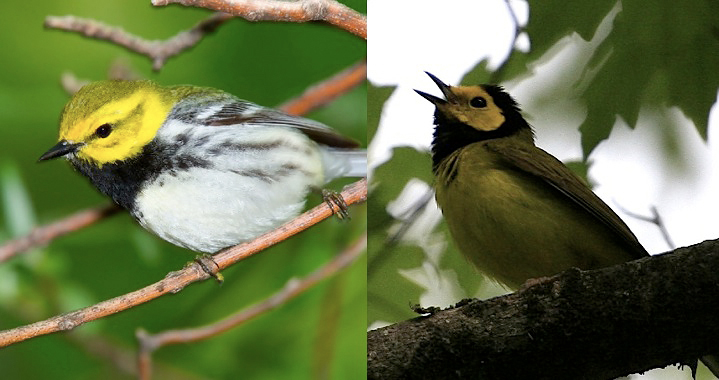
Fig. 4.3.1: Flash versus ambient light. The bird on the left (a
Black-throated Green Warbler)
was photographed using flash, while the bird on the right (a Hooded
Warbler) was photographed
without the use of flash. Notice that the the flash has not only
brightened the subject and scene,
but has also resulted in more vibrant colors.
A second reason
to use external flash is that for birds not in direct sunlight, the use
of flash can result in more vivid colors, as illustrated by the figure
above. The bird on the left was illuminated with flash, while the
bird on the right was not. As you can see, both the bird and the
leaves and branches in the background have more vivid colors.
Part of the reason is that the light emitted by most flash units is set
at a color temperature which
mimics direct mid-day sunlight, whereas the ambient light which
illuminates a subject in shade has different color
characteristics. While it is possible to adjust the color
temperature in software (or even via the white balance setting in your
camera), the use of higher ISO to increase image brightness still
results in less color information (recall from section 2.5 that higher
ISO settings don’t actually force the collection of more light; rather,
they artificially amplify the signal and noise coming from the
photosites), so that color adjustments in software often result in
unpleasant artifacts in the image, such as regions that appear too
saturated. In general, it’s best to get the lighting correct in
the field, rather than trying to patch up the image later via digital
manipulation.
The third, and far less well-known (among novices),
advantage of flash when shooting birds is the effect it can have in
bringing out microscopic features, such as the minute structure in the
surface of feathers. The image below gives an example of this.
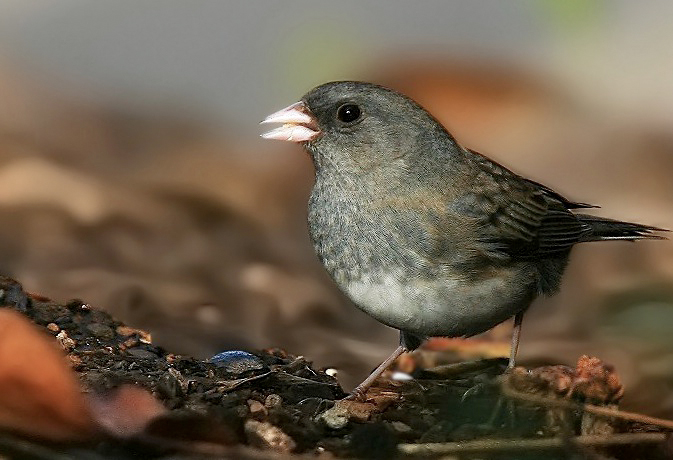
Fig.
4.3.2: Flash and micro-contrast. The use of flash can bring out
fine details
in bird feathers, which ambient light rarely does (though direct
sunlight can
sometimes produce a similar effect, when shining from the proper angle).
Unlike
ambient light, flash light comes from just one direction: from the
location of your camera (unless you’re using a remote flash, which we
won’t consider here). If you think about what happens to the rays
of
light coming from an external flash unit, you can imagine that these
rays strike parts of the bird and then reflect off the bird in some
direction. Those rays that reflect back at exactly the proper
angle
will be collected by your camera’s imaging sensor, while the rest will
not. Since the angle of reflection is determined by the relative
angle of the feature of the bird that has been struck by that ray of
light, the camera’s sensor will register more light (far more, in many cases) from those
microstructures in the bird that happen to be almost perfectly parallel
to the plane of the imaging sensor. This is illustrated in the
figure below.
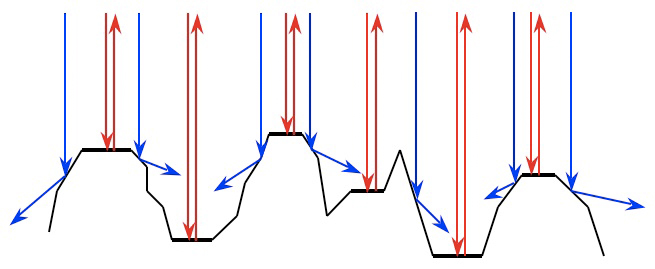
Fig. 4.3.3:
Microscopic features of the subject which are parallel to the imaging
sensor reflect flash light directly back to the camera, whereas facets
not
parallel to the sensor cause light to scatter. This effect can
greatly increase
the apparent level of detail in the resulting photo.
Each ray of
light coming from your flash unit is represented in the figure above by
a vector—i.e., a straight
line with an arrowhead indicating direction. The black contour at
the bottom of the image represents some microscopic surface on your
subject—perhaps the microscopic surface of a feather, for
example. Those surfaces which are perfectly parallel to the
imaging sensor (which is not shown in the image, but you can imagine it
off beyond the top of the figure) are shown to reflect their incident
flash vectors (drawn in red) back in the same direction whence they
came—back toward the camera. Flash light striking non-parallel
surfaces (shown as blue vectors in the figure above) reflect at odd
angles which mostly don’t direct them back toward the camera, so
they’re effectively lost.
The result is that the imaging sensor in the camera
receives a much higher intensity of light from the parallel
microstructures in the bird’s plumage (and other features), resulting
in enhanced contrast at the microscopic level—what I call micro-contrast. In this way,
the use of flash can produce substantially more detail in the resulting
image than would otherwise be possible, and this isn’t simply due to a
brighter image: it’s due to the use of a strong unidirectional light
source. This effect isn’t as well known outside of bird
photography, because most other subjects either don’t have the same
degree of microscopic detail as do birds, or if they do have such
detail it’s typically not aesthetically pleasing (e.g., microscopic
imperfections in human skin).
One disadvatage of flash, both for people and for
birds, is that it very often results in artifacts appearing the
subject’s eyes. In humans, this is known as red-eye. In birds, it can
take the form of red-eye (which typically results from reflections off
of blood vessels in the eye) or steel-eye
(which results from reflections off of the highly reflective surfaces
at the back of the eyeball—which presumably are an evolutionary
adaptation that aids in increased light collection in dim
environments). The figure below shows an example of red-eye in
birds. Steel-eye, which typically shows up as a bluish or whitish
reflection (rather than reddish) seems to be more common.
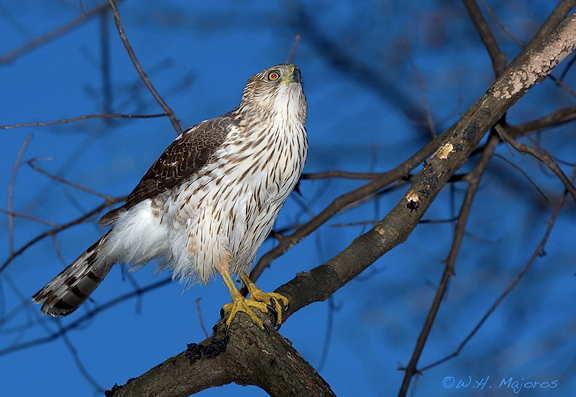
Fig. 4.3.4:
Flash can cause red-eye in some birds, just as in humans. In most
birds, however, it tends to cause steel-eye, which appears bluish or
whitish.
Despite the problem of red-eye and
steel-eye, I think the potential advantages of the use of flash for
bird photography far outweigh the disadvantages. As we’ll
describe in Chapter 11, elimination of red/steel eye in postprocessing
becomes relatively easy with practice, and as mentioned below, some
steps can be taken to prevent its occurrence in the first place.
4.3.1
Models and Power
Once you’ve acknowledged that the use of flash (at least some of the
time) is necessary or at least useful for bird photography, the next
step is to realize that the tiny flash unit built into your camera
isn’t powerful enough for general bird photography scenarios—i.e.,
situations other than the one in which you’re sitting at a window,
three feet from a bird feeder. As the figure below should
suggest, internal (i.e., built-in) flash simply can’t compete with the
power output of a dedicated, self-powered flash unit.
Fig.
4.3.5: Bigger is better in the world of flash units.
The external flash unit on the right can produce a
substantially more powerful burst of light than
the built-in unit on the left.
Modern flash units are rated in
terms of guide numbers.
The guide number indicates the overall power output of the flash
unit. Understanding the theory behind guide numbers is
essentially useless when shopping for a flash unit, since for bird
photography you only need to know one thing: the more powerful the
flash, the better. For portrait and wedding photographers, a unit
with only moderate power output may be more than sufficient, but for
really serious bird photographers, no amount of flash power is ever
truly enough; there’s always a bird that’s just too far away for the
flash unit to effectively illuminate it. The bright side (no pun
intended) of this situation is that choosing a flash unit thus reduces
to a simple financial question: what
is the most powerful flash unit you can afford? Although I
do very strongly recommend buying the most powerful flash you can
afford, there are ways (as we describe below) to increase the effective
output of a given flash unit, by restricting and refocusing the flash’s
emitted light.
4.3.2
Fresnel Extenders
One of the most notable developments in bird photography in recent
years has been the widespread availability of the fresnel extender. I recently
had the pleasure to meet the man who is largely responsible for making
this technology available, affordably, to masses of bird
photographers. Walt Anderson’s now-famous Better Beamer flash extender
utilizes a simple and highly economical method for concentrating flash
output into a smaller area than would normally be possible with the
naked flash head. The figure below shows the Better Beamer (two
of them, in fact) in action in the field.
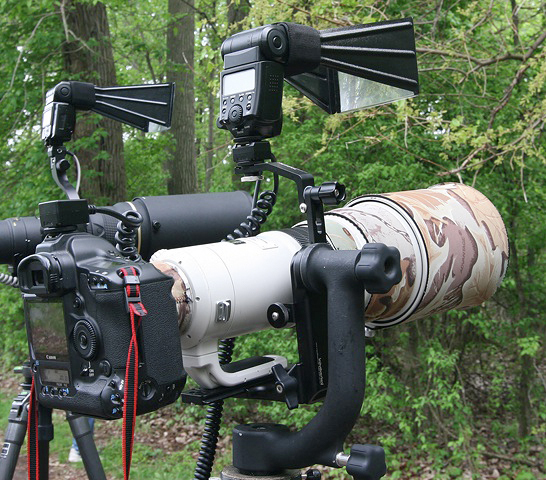
Fig. 4.3.6: Two
camera rigs with fresnel extenders attached.
The Better Beamer is by far the most popular fresnel extender
among bird photographers. It’s cheap, lightweight, and effective.
As you can see, the beamer is a simple device which attaches to the
front of your external flash unit, via velcro straps. The above
photo was taken during a bird migration festival at a migrant trap in
Ohio. Though you can see only two lenses in this figure, had I
used a wider-angle lens to snap this photo you’d see a line of 15 or 20
tripod-mounted lens, nearly all of them surmounted by a
fresnel-extended flash unit. The extenders shown above are very
affordable—I got mine for about $35.
A fresnel extender is simply a lens. Like any
lens, the extender works by refraction—that
is, by focusing light to a point (or at least to a smaller area than
would otherwise naturally occur). The light emitted from a flash
unit tends to spread out over a wide area, which for most types of
photography is a good thing: the goal is typically to illuminate an
entire scene. But with a super-telephoto lens in the 400mm-800mm
range, the field of view is so restricted that much of the illuminated
scene isn’t even visible in-frame. An enormous amount of flash
light is wasted on parts of the scene which won’t even appear in the
photo. A fresnel extender simply takes that wide cone of light
and narrows it, so that it is concentrated in the part of the scene
which does fit
in-frame. As a result, the amount of light striking the bird can
sometimes be enormously greater than without the fresnel.
There are two main advantages to this. For
birds that are at relatively large distances from the camera, the use
of a fresnel extender can make the difference between illuminating the
bird and not illuminating the
bird. I once lit up a heron at 200 feet (!) in pre-dawn lighting,
using a home-made “mega-beamer” (the heron is shown just below,
while the beamer is shown in the figure that follows). Without
the extender, the flash would have had no discernible effect on the
illumination of the bird.
Fig. 4.3.7:
Heron at 200 feet. This bird was illuminated in predawn using a
monster
“mega-beamer” (see next
figure, below). The left image was taken without flash,
the right image with flash. Notice the extreme steel-eye in the
bird, which would
have to be fixed during postprocessing (i.e., in Photoshop).
The other advantage of using a fresnel extender is that for birds at
closer ranges, you can turn down the power output of your flash unit,
thereby conserving your batteries. It’s a well-established fact
that flash units can eat batteries even faster than the Cookie Monster
can eat Oreos.
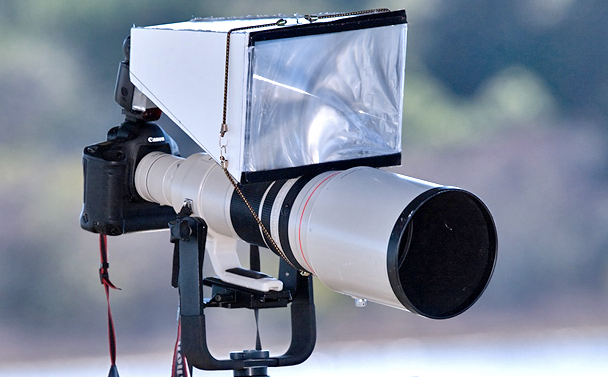
Fig. 4.3.8:
Better than the Better Beamer. This monster beamer
was constructed by the author from readily available materials,
and provides significantly better power and range than smaller
extenders, while costing less.
Although the
Walt Anderson Better Beamer
is a very affordable and effective flash extender (and extremely
popular among birders), for really serious bird photography at large
focal lengths I recommend building your own “mega-beamer” like the one shown in the figure
above. This unit provides significantly more illumination at
longer distances than the much smaller commercial device. The
unit shown above took me an hour to build using locally-available parts
totalling about $25 US. A brief description of how to build your
own mega-beamer follows; feel free to skip to the next section if
you’re not interested in building a beamer right now.
To build a mega-beamer like the one shown above, you
just need four components: (1) a large piece of fresnel, (2) some
foam-core, (3) a few strips of velcro, and (4) some hot glue.
Obviously, you’ll also need a glue gun to apply the glue, and also an Xacto knife or a razor blade to cut
the foam core. I found all of these parts within a few miles of
my home. The fresnel is sold at large bookstore chains like Barnes and Noble (and probably Borders) for about $9 US.
Foam-core is sold at Michael’s
art supply store, as well as some large grocery chains like Kroger’s. Michael’s also
sells glue sticks and dirt-cheap glue guns, as well as velcro.
The most difficult part of the process is
determining the appropriate dimensions of the foam-core panels, given
the lens you intend to use the unit with. Because the unit rests
on the lens (typically), and because aiming of the light path is
crucial to getting proper exposures, this part of the design will be
specific to your particular lens and flash unit. For the unit
shown above, each piece of foam-core is 15 inches long. This
assumes a focal length at infinity
of around 14.5 inches for the fresnel lens, which can differ between
types of fresnel, and is very probably not correct even for the unit
shown above. However, conventional wisdom (among those who’ve
built these types of devices) suggests that getting the dimensions
exactly right isn’t terribly important.
Before settling on the dimensions for your unit,
however, I recommend finding the distance at which your piece of
fresnel can sit atop your lens and be perfectly centered (or nearly so)
with respect to your flash unit’s flash head. At this distance,
your fresnel should be (roughly) properly aimed for objects at
infinity; moving it slightly closer to the flash may be advisable for
convergence on birds at close-to-intermediate distances.
Once you’ve settled on the distance at which to place the
fresnel from the flash head, the dimensions of the foam-core pieces are
easy to deduce, given the dimensions of your fresnel lens, the
dimensions of your flash head, and some simple geometry. The
figure below shows how to compute the lengths of the top and bottom
pieces of foam-core; the lengths of the side peices can be computed
similarly by using the width
(rather than the height as
shown in the figure) of the flash head for w and the width of the fresnel for y.

Fig. 4.3.9:
Measurements for building a mega-beamer. Find the
distance x such that your fresnel sits atop your lens while still being
centered with respect to the flash head. Then apply the formula
above
to compute the length z to be used for the foam core. The
computation
for the side pieces is similar (see text).
Assembling the
parts is now easy. Simply attach the foam-core sides to each
other using hot glue, and then attach the fresnel using paired velcro
strips. I prefer to use the velcro rather than gluing the
fresnel, so that it can be removed and cleaned, and so that the insides
of the whole unit are much more accessible for cleaning as well.
For my unit I also lined the interior with aluminum foil, to increase
reflectivity of the inner walls of the chamber. If you don’t feel
like taking the trouble to line yours with aluminum foil, I at least
recommend choosing white foam-core rather than black, for the added
reflectivity.
To finish off the unit, you’ll probably want to
install some styrofoam spacers to the inner opening to make it fit
snugly to your flash head. To stabilize the extender in the field
I also use some mini-bungee cords from Wal-Mart, which wrap around the
extender and the lens. After building the unit you should aim it
by pointing your lens at a fixed point and engaging the flash. If
the flash is aimed too low you can prop it up by employing some sort of
spacer beneath the forward edge. For my unit, it turned out that
it was aimed too high, so I had to carve out a shallow crescent in the
lower surface of both the bottom foam-core piece and the fresnel, so
that it could sit lower on my lens.
An important caveat must be noted with regards to
the use of flash extenders. If you inadvertently allow the
fresnel to point into the sun, the sun’s rays may be focused by the
fresnel onto your flash head, and may
very well melt your flash head! Many users of fresnel
extenders have learned this the hard way. Using an enclosed
design like the one shown above may help to some degree, but
significant damage is still possible, so beware. Also, when the
extender is not mounted on your flash unit, any other object (such as a
hand!) placed at or behind the smaller opening is at risk of damage
from focused sunlight. (The
design of of the flash extender shown above is provided with no
warranty, neither explicit nor implied. Readers who build and use
such a unit do so entirely at their own risk.)
4.3.3
Off-shoe Cords and Brackets
In Figure 4.3.6 above, you can see that the external flash unit is not
mounted directly onto the camera’s hot
shoe, but is instead mounted on a metal bracket which attaches
to the tripod head. The bracket effectively raises the level of
the flash unit, thereby increasing the angle of light that reflects off
of the bird and reaches the camera’s imaging sensor. Increasing
this angle can often reduce the incidence of red-eye or steel-eye in
birds, thereby eliminating the need to manually adjust or edit the eyes
in postprocess. Two complications of this setup are that you also
need an off-shoe cord to
attach (electronically) the flash to the camera body, and that you
(obviously) need to pay for both this cord and the metal bracket.
The bracket is often the more difficult problem, since you need to find
a bracket that is compatible with both your particular flash model and
your particular tripod head. Using a flash bracket may also
complicate the deployment of a custom fresnel flash extender like the
one shown above in figure 4.3.8.
4.3.4
Batteries and
Refresh Rate
Although camera batteries have advanced in recent years to the point
where they can (for many DSLR models) power the camera for thousands of
exposures before needing to be recharged, flash units seem to be
insatiable in their consumption of battery power. Most
consumer-grade flash units operate on AA-type batteries, typically
taking four AA’s internally, and in some cases allowing their voltage
to be supplemented via external battery packs. I use an external
pack made by Canon which takes eight AA batteries; this is in addition
to the four AA’s used internally in the flash unit itself. During
really serious, day-long shoots, I’ll typically swap out the full set
of twelve AA’s once around mid-day, so that for a ten-to-twelve hour
day of extreme birding I’ll very often burn through 24 batteries.
For week-long trips to special locations, I’ll do this over consecutive
days. Obviously, that can add up to quite a lot of used batteries.
The most practical solution is, of course, to use
rechargeable batteries. I currently use primarily Energizers, though in the past I’ve
used Sony and Impact with much success.
When on a birding trip, I typically need to recharge large numbers of
AA batteries each night in prepration for the next day’s shoot.
When staying in hotels, an added inconvenience is the sometimes small
number of available electrical outlets in the room. I’ve been
able to overcome this problem by employing what I call the Squidmonster, which is illustrated
in the figure below.
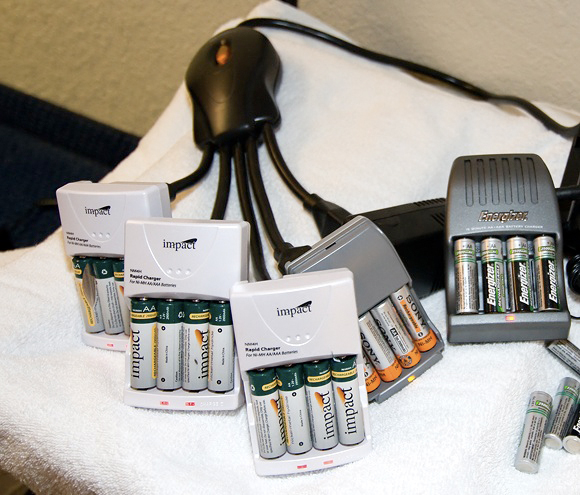
Fig. 4.3.10:
The Squidmonster. Finding enough electrical outlets
in hotel rooms for all your battery rechargers can be a challenge.
The Power Sentry “Squid” solves this
problem far better than
standard “power strips”, which
typically don’t have enough
physical space for five AA chargers.
The Squidmonster consists of
a Power Squid (the black device shown in the upper part of the image)
manufactured by the company Power
Sentry, together with a number of battery-specific chargers
attached to the Power Squid’s arms. With the 5-arm Power Squid,
you can charge twenty AA batteries at the same time, while taking up
only a single electrical outlet. In some hotel rooms this is
extremely convenient, since you’ll typically want to use any other free
electrical outlets for your laptop computer and the power supply for
your external hard drive.
I especially recommend the Energizer 15-minute
recharger. Not only does this recharger allow you to recharge
large numbers of AA batteries in just a few hours, but some models also
include a car adapter which fits into your car’s cigarette
lighter. In an extreme emergency, you can use this latter feature
to replenish your flash power very quickly, at the expense of a little
gasoline.
In addition to powering your flash unit for day-long
shoots, external battery packs can often reduce the time it takes for
your flash head to recharge in prepration for the next exposure.
This time delay depends on the power level that you have the flash unit
set at. For full-power bursts, without the external battery pack
you might have to wait five or ten seconds between exposures if you
want the flash to fire at the desired level. I typically operate
my flash unit at 1/4 power, which, with the external battery pack
(eight AA’s) attached, can often recycle in less than a second.
For high-frame-rate capture, this setup often fails to provide
consistent exposure—especially at 8 or 10 frames-per-second (fps).
For high-frame-rate flash photography, a number of
birders resort to dedicated battery packs from companies such as Quantum. These packs often
cost well over $500 US, and incur significant risks in their use.
The first risk has to do with over-use of the pack, which can result in
thermal damage to the flash unit. Canon and Nikon provide
recommendations in the user manuals for their flash units, in terms of
the maximum number of full-power flashes (or even half-power flashes)
that should be attempted within a short period of time. To avoid
heating up the flash head to dangerous temperatures, these recommended
limits on numbers of full-power flashes per minute (or per ten minutes,
or thirty minutes, or sixty minutes, etc.) should be carefully
observed. Some newer flash units include built-in safety features
that will shut off the unit if the recommended limit is reached, or if
the temperature of the flash head gets dangerously high. Units
without such a safety mechanism will simply melt if overused. For
$400 and $500 flash units, that’s not a terribly rosy prospect.
I personally encountered a different problem with a
third-party battery pack (the Quantum
Turbo) during a two-week trip to a warbler migration
hot-spot. This $600 battery pack fried two of my $400 Canon flash
units within minutes of being attached. Canon repaired both units
at a cost of $120 per unit. Canon’s repair technician concluded
that the flash units had received an inappropriately high voltage from
the external power supply, resulting in fried circuitry (i.e., it was
not simply due to over-heating or over-use). While the
technician’s report clearly indicated that the third-party power supply
had been the cause of failure in both flash units, and that there was
no indication of over-heating (and hence no evidence of faulty use by
the photographer), the manufacturer of the battery pack refused to
accept responsibility for the damage to the flash units, insisting
instead that Canon’s flash units must have been defective (despite my
having used them for many months prior with no problems). Though
the flash units were repaired at a cost of only $120 US per flash, I
also incurred a cost of $800 for a new pair of flash units to stand in
for the fried units, since I was on a critical shoot far from home, and
the migrating birds refused to wait 14 days for the Canon repair
facility to fix the broken units.
My recommendation is to steer clear of all third
party battery packs, especially those manufactured by Quantum.
Canon’s 8-battery (AA) pack, which runs about $130 US, provides nearly
the same refresh rate as the far more expensive (~$600 US) Quantum
product, without the associated risk that comes with using questionable
third-party equipment which may also void the warranty on your
expensive flash unit. Note, however, that even with the AA
battery pack, it’s still possible to melt your flash unit if you
rapidly fire off too many full-power (or even half-power) flash
discharges. Be sure to consult the user manual of your flash
model and observe the manufacturer’s recommendations for safe operating
of the unit.
|
